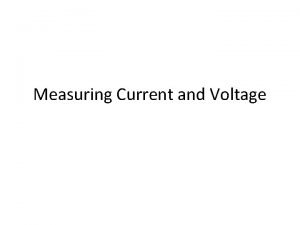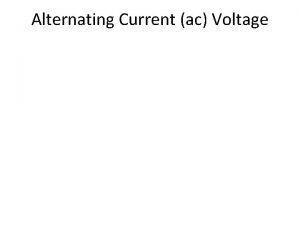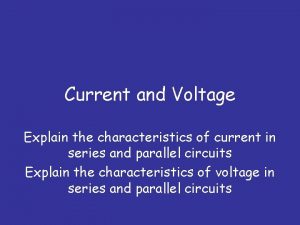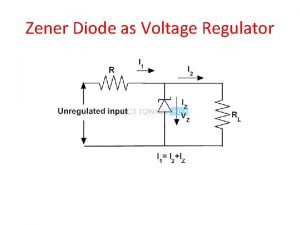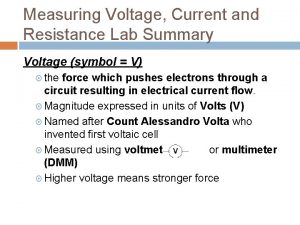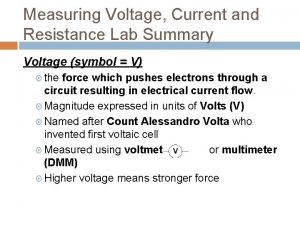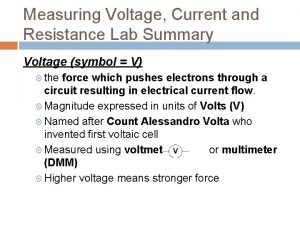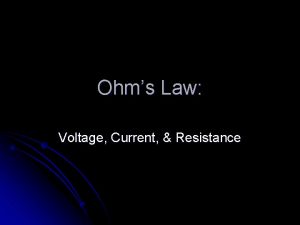Voltage Current Characteristics Elliott Voltage Current Characteristics From


















- Slides: 18

Voltage Current Characteristics Elliott

Voltage Current Characteristics From this circuit we take readings of voltage and current plotting them as a graph called a VI characteristic. We normally put the voltage on the yaxis and current on the x-axis. This allows us to determine the resistance from the gradient. Is this a graph of an Ohmic or Non-Ohmic Conductor?

• The straight line shows a constant ratio between voltage and current, for both positive and negative values. We say that the voltage is directly proportional to the current. • This means that the graph is a straight line of positive gradient going through the origin. • When the voltage is negative, the current is negative, i. e. flowing in the opposite direction. Ohm’s Law is obeyed.

Exam Trap • In the exam, you will, most likely, see that the current is plotted against the voltage. Therefore the gradient is the conductance, and you have to find out the reciprocal to get the resistance. • The higher the resistance, in this case, the less steep the gradient. • It is entirely possible that the graphs are plotted with the voltage against the current. Read the question carefully!

Filament Lamp The resistance rises as the filament gets hotter, which is shown by the gradient getting steeper.

Can you explain why the graph suggests that a light bulb does not obey Ohm’s Law?

Answer • The graph is curved, because the resistance increases (as shown by the gradient). • Filament gets hot. • The resistance goes up, • because the raised temperature causes more vibration of atoms, • leading to increased chances of collisions

Look Closer Does this graph really suggest that increasing temperature increases resistance? What might be going on?

The Thermistor • A thermistor (a heat sensitive resistor) behaves in the opposite way. Its resistance goes down as it gets hotter. • This is because the material releases more electrons to be able to conduct. Where might you use a thermistor?

Why Does Thermistor give This Graph? • As the current goes up, thermistor gets hotter. • As it gets hotter, it allows more current to flow; • Therefore it gets hotter and so on. This is called thermal runaway, and is a feature of many semi-conductor components. At the extreme the component will glow red-hot, then split apart.

Check Your Progress Why does a thermistor not obey Ohm's Law?

Answer Graph is not a straight line. The thermistor gets hot, therefore the resistance decreases.

Diodes are semi-conductor devices that allow electric current to flow one way only. • If the positive of the diode is connected to the positive terminal of the battery, the diode will conduct. • The voltage across the diode is about 0. 6 V. • This is called forward bias. • The negative terminal, sometimes called the cathode is shown by the silver band.

Measuring the Characteristic of a Diode The circuit to measure the characteristic of a diode is like this, based on a potentiometer. The potentiometer allows a range of values from 0 volts to the battery voltage. We will look at the potentiometer in more detail later.

Diode Characteristic Graph The diode starts to conduct at a voltage of about +0. 6 V. We call this forward bias. Then the current rises rapidly for a small rise in voltage. If the current is reversed (reverse bias) almost no current flows until the breakdown voltage.

You May See This Graph… If the current is reversed (reverse bias) almost no current flows until the breakdown voltage. At this point, it will conduct fully but usually destroy the component entirely.

Check Your Progress Can you use the graph to explain why a diode allows a current to flow one way only? 6 marks

Answer • Diode conducts at 0. 6 V when forward biased. • But does not conduct when reverse biased. • Until the breakdown voltage, • when it suddenly conducts fully. • Usually the component is destroyed.
 What is considered high voltage
What is considered high voltage Ac voltage controller applications
Ac voltage controller applications Line vs phase voltage
Line vs phase voltage Converting rms to peak
Converting rms to peak What is the objective of earthing
What is the objective of earthing Elliott erwitt biography
Elliott erwitt biography Career cruising yrdsb
Career cruising yrdsb Dana elliott
Dana elliott Pierre elliott trudeau high school courses
Pierre elliott trudeau high school courses Pierre elliot trudeau high school
Pierre elliot trudeau high school Dr elliott mayo clinic
Dr elliott mayo clinic Michael elliott md
Michael elliott md Dr suzanne elliott
Dr suzanne elliott Pierre elliott trudeau high school courses
Pierre elliott trudeau high school courses Elliott lancaster
Elliott lancaster Elliott durham school
Elliott durham school Kathryn elliott
Kathryn elliott Elliott business software
Elliott business software Sandy elliott
Sandy elliott




















